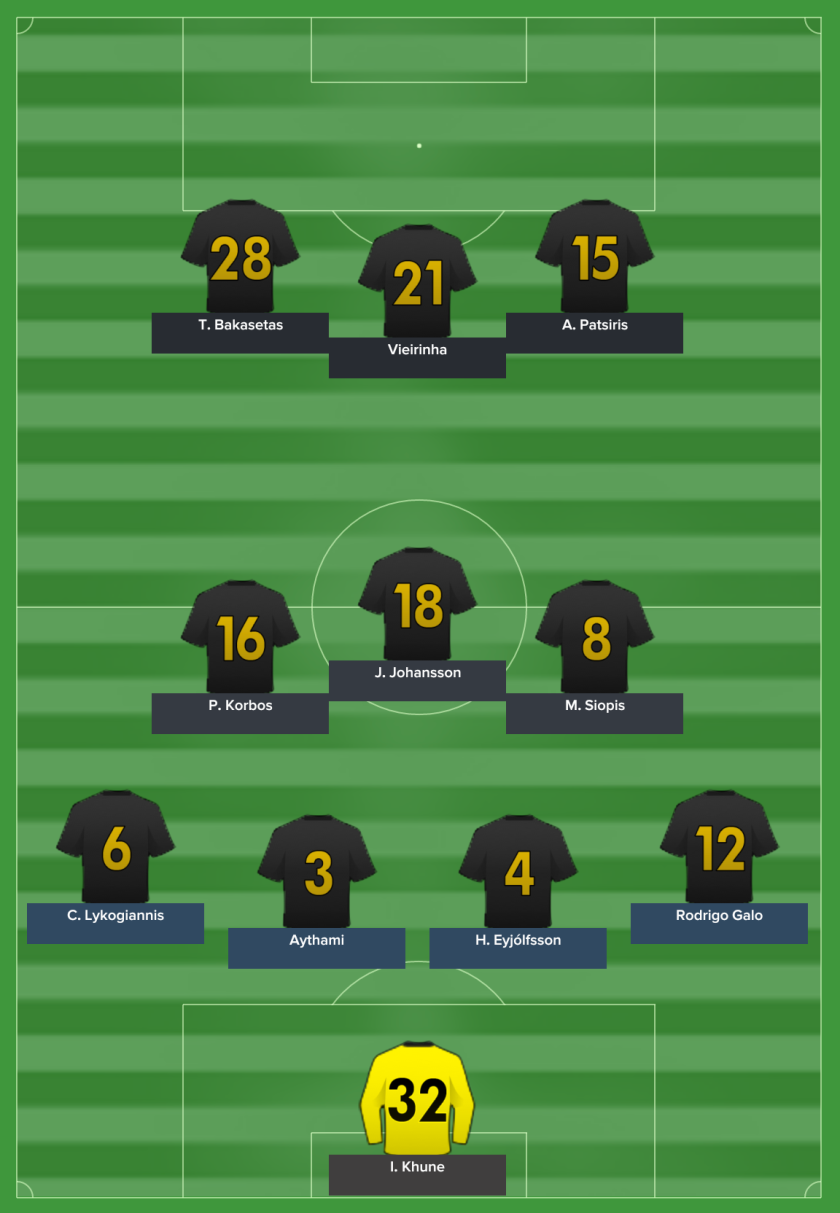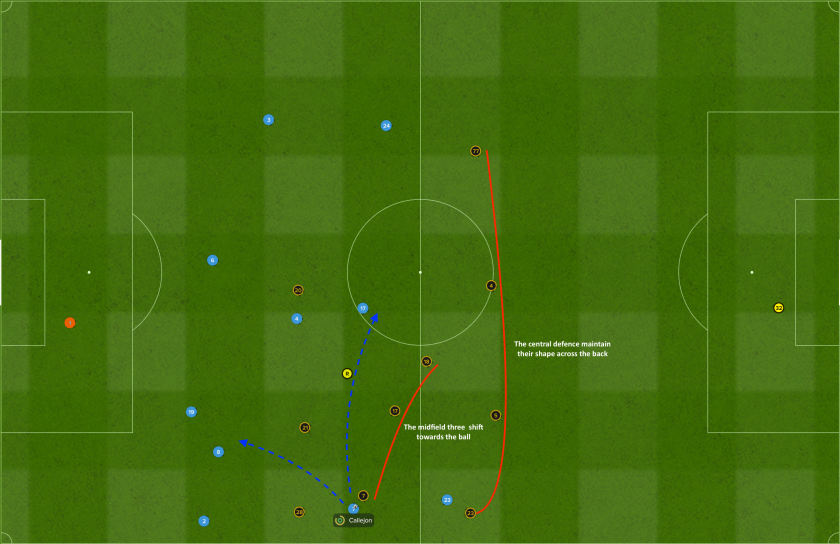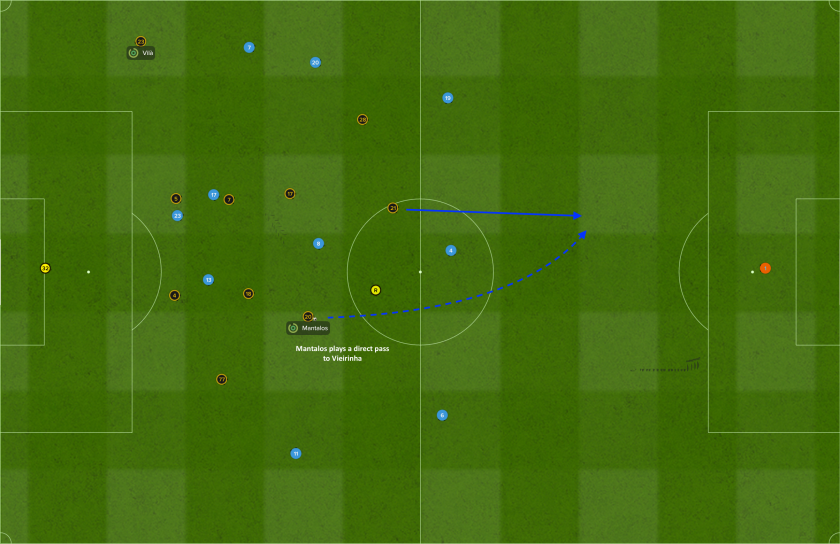This is a first guest appearance from Oliver Jensen, a.k.a fmfutbolmanager. Oliver has an excellent eye for analysis and a methodical approach to complement his tactical know-how. Follow him on twitter @fmfutbolmanager or find him on Slack/SI forums under the same nickname.
Welcome to my first post on FM Asymmetric. I want to write about the simplicity of football and how I implement my tactical approach in Football Manager. As the great man Tony Adams once said, you just have to keep the ball out of one end, and stick it in the other.
Some might have read my thread on the SI forums regarding my AEK save and the tactics I employ. This is an adaptation of that. My system has changed, but the underlying philosophy is the same.
The basic premise for the type of football I want to play is predicated on controlling possession of the ball, creating space in advanced areas to exploit, and above all else, being patient and methodical in our approach so that we do not aimlessly give away possession of the ball. I am not talking about the Louis van Gaal approach of holding possession for the sake of having the ball, that is torturous football, our possession needs to lead to a positive action. But not being afraid to circulate the ball and regroup if no positive action is immediately forthcoming.
So, how do I put that into practice?
Playing Style
Control possession of the ball. The solution:
- Overloading the opposition in advanced areas, ensuring we always have a passing option. Achieved by increasing the players available in the positions we have the ball. Playing with two banks of three in the middle in a fluid shape will create overloads coupled with playing through the central areas
- Playing with a Much Lower Tempo
- Playing out from the back. Analysing passing options and not clearing the ball up field. Achieved by instructing the Sweeper Keeper to Distribute to Centre Backs
- Reducing the freedom to dribble with the ball. Achieved by instructing players to Dribble Less
Creating space in advanced areas of the pitch to exploit. The solution:
- Increased fluidity throughout the team, disrupting the opposition shape through quick movement of the ball and fluidity in player movement. Achieved by using a Very Fluid team shape
- Increased creative freedom, allowing the players freedom to play outside of the tactical setup when required. Also achieved by using a Very Fluid team shape
- Having options out wide, taking the attention of wide defenders and stretching the defence, coupled with allowing players to move into channels to take defenders with them. Achieved by playing with Wing-Backs who are instructed to Stay Wider
Being patient and methodical in our approach. The solution:
- Playing at a Much Lower Tempo
- Providing passing options. Achieved by overloading the areas of the pitch we concentrate our attacks, i.e., the central areas and using a very fluid shape
- Restricting freedom to shoot from outside the box. Achieved by instructing players to Shoot Less Often
To achieve the aforementioned playing style, our tactical instructions look like this.
- Tempo: Much Lower. This allows us to retain possession of the ball, without using the retain possession instruction. I don’t want to retain possession all over the pitch, for example, I don’t want us keeping the ball in the final third of the pitch. I want us to keep the ball at the back and work the ball around the midfield, but when the opportunity comes for a quick break I want my players to have the freedom to play a risky ball to unlock the defence.
- Width: Fairly Narrow. Whilst we will inevitably be narrow by virtue of the player positions and roles, I want to enforce the mantra of keeping the ball flowing through the middle of the pitch
The Defence instructions look like this:
- Use Tighter Marking. As I alluded to earlier, we have limited presence on the wings, so I use tighter marking to ensure my defenders stay with their man when the balls are crossed into the box. This is perhaps a contentious issue, given the effectiveness of crossing, but I like to believe the fluid team shape allows for more bodies in the box and this helps keep the opposition covered. I also want to suffocate opposition attacks and remove passing options for them to force them into making a mistake.
- Tackling: Stay on Feet. A simple one really. I don’t want my players diving into challenges. If you’re on your feet when winning the ball you can distribute it a lot quicker and maintain possession rather than sliding in and losing control of the second ball.
The Build-Up instructions look like this:
- Passing: Play out of Defence, Exploit the Middle. With the low tempo encouraging possession football and the controlled build up I want to employ, it makes sense to ask the defence to play their way out from the back. Our fluid shape allows for options to do this.
The Attack instructions look like this:
- Dribbling: Dribble Less. I don’t want the team looking to retain possession of the ball in the final third by dribbling their way out of trouble. Rather I would prefer them to look to the extra man to make a pass to, or to fire a through ball over the defence to create a better opportunity. It is going to get pretty congested in the middle of the pitch and we don’t have a Messi. So this instruction should make the players look for better options.
- Freedom of Movement: Roam from Positions. It could be argued that our fluid shape allows for more freedom of movement. But I want to emphasise that we should be looking to move freely and draw the opposition out of position. The players need to be available for each other in order that we don’t concede possession cheaply.
The formation, player roles and duties
In terms of our formation, we line up in a 4-3-3-0 strikerless system. The formation is just a basic construct, and not really essential to what we are trying to achieve. It is the roles and instructions given to the team and players that define our system. These ensure we are supporting the ball when in possession, and have sufficient positional cover for when we are out of possession.
The crux of our shape is the deep pentagonal centre, formed of two Central Defenders, two central Ball Winning Midfielders and a Roaming Playmaker, through whom most of our play will originate. This is where the majority of our possession is held, with the supporting central attacking midfielder dropping to assist. Having these natural triangles when designing the system will lead the players to form triangles in possession.
In terms of the player roles and my expectations of them, here’s a little more detail.
A supporting Sweeper Keeper sits at the base of the system. He is our first line of attack and plays an important role in building from the back. Excellent passing and throwing attributes help keep possession with us. He is instructed to distribute quickly and to the central defenders. Additionally, he gives us an extra passing option at the back.
Two covering Central Defenders are there to sit back and attack anything that penetrates our midfield. They’re asked to mark tightly and tackle harder.
Two supporting Wing-Backs flank the covering central defenders. These players are given the most instructions of all the players as I want them performing a very specific role for me. I instruct them to mark tighter, close down much more, and tackle harder. They’re also asked to stay wider to give us the width to stretch play and open up spaces in the defence. Finally, I ask to cross to the near post.
Two defensive Ball Winning Midfielders sit in the centre of the pitch. Their job is to drop deep and chase down anything that comes near them. Our fluidity means they also move to wider areas to support the Wing-Backs in closing down anything on the flanks.
At the top of the pentagon is my Roaming Playmaker. He is the spearhead for our attacks. Our central defenders and midfielders look for him when regaining possession and he is in control of the transition and decides whether to move the ball out wide or proceed through the middle. Strong both defensively and offensively.
Our front three consists of two Shadow Strikers flanking a Trequartista. My Trequartista is the attacking pivot (if you think of the Roaming Playmaker of being the defensive pivot), who offers a creative outlet further afield. The Shadow Strikers are there to offer the furthest options for through-balls and ultimately, goals.
Now, how does all this look on the pitch?
Analysis of our defensive play
Defensively we keep things very simple. At the top of the pentagon, the players push the opposition player on the ball out wide. The central defenders stay deep. The wing-backs attack anything that moves out wide. When the ball moves wide the ball winning midfielder on that side covers with the roaming playmaker.
As we sit back deep, we’re happy to let the opposition have the ball in and around the half way line, as it moves towards us it is shifted out wide by our positioning. Notwithstanding the way the game mechanics may or may not overpower full-backs and crosses, this is where you can really push the opposition into making a mistake, essentially using the touchline as an additional blocker. [Select the left image for a larger view]
Overloading the attacks as they come down the wings is a simple and effective tool for quickly winning back possession and springing counter attacks. In this example, the ball shifts from right to left but is easily intercepted by our wing-back to prevent another attack.
In the final example, Napoli had the ball in the central area again, our pentagonal shape gives them options out wide, but nothing much through the middle. [Select the left image for a larger view]
Analysis of our attacking play
When attacking, we transition quickly from the defensive phase. Breaking at a fast pace to disrupt the opposition whilst they’re out of position and not yet in their defensive shape. When the opposition is out of position, there is always space to exploit. If you have quick and explosive players, with good decision making and with good off the ball and anticipation you can take advantage of that. [Select the left image for a larger view]
As you can see from the scenario, the back three of Napoli are wide apart and the midfield is positioned more advanced than our attacking midfielders. When the ball is launched forwards from my wing-back a quick counter results in a really nice goal. My wing-backs are instructed to play more risky passes, and in this case, it pays off with a pass across the middle of the park.
The diagonal pass into the forwards breaks the horizontal and vertical lines within Napoli’s defensive shape. Taking advantage of the wide defence and high line when Napoli attack was key to our 4-1 victory over them in the Champions League. Constantly breaking these lines with our running and use of the ball created disruption and space.
In the scenario below we again win the ball deep, launch it up to our attacking three, who have good decision making, vision and passing ability which helps to move the ball quickly into dangerous areas. Again breaking both horizontal and vertical lines, we are able to exploit the spaces left by Napoli. [Select the left image for a larger view]
Although in the above scenario Napoli got back to defend, we were able to work the ball out wide and recycle possession. By virtue of the shadow strikers inclination to move into channels, the defence lose their shape marking him. This opens up space for our playmaker to receive the ball in zone 14 for another goal for our trequartista, provided by a nice through-ball.
In this final scenario, we demonstrate our positional play. Using possession as a tool, rather than a philosophy, we are able to move the opponent out of position to free up the third man in dangerous and exploitable areas. Typically this will be our trequartista, as he is free to roam between the opposition central defenders whilst they’re occupied with the shadow strikers moving into the channels. Moving the ball quickly out wide and back into the central areas again, we free up midfielders to pick out simple passes. [Select the left image for a larger view]
Conclusion
To summarise, we had our best season yet with this system. We won the league with only one loss and got through the group stages of the champions league. Defensively, I’m very happy with how the system is performing. Offensively we’re creating a lot of chances through the middle, and breaking the lines with pace, which in turn causes disruption to the opposition organisation which naturally leads to space to exploit.
I will close out this post with some statistics from the league. We have almost double the number of passes of any other team in the league, with superior passing accuracy. And probably more importantly, we’re by far the best at hitting the target with our shots due to the number of quality chances we create through the middle. [Select the top image for a larger view]
You can read more about my save over on the SI Forums, or visit my channel on the FM Slack, -fmfutbolmanager
Thank you for reading.
Oliver Jensen





















Very interesting Oliver! The few time I’ve set-up a strikeless formation, I’ve noticed how effective it is in exploiting space, particularly between the defence and midfield or behind the defence. You explained this perfectly.
I have a question regarding your fullbacks, in one of the images they are shown pressing, doesn’t this leave you exposed on the side sometimes? I ask you because I’ve always been undecided whether to ask them to press as much as the midfielders or less in order to keep the defensive line – never came up with a definitive answer. Thanks!
LikeLiked by 1 person
Hi Metodo, thank you for the comment.
I haven’t noticed too many issues at the moment, I think that’s partly helped by the ball winning midfielder on the sides also being set to aggressively press, so I find this helps in the scenario where the opposition has two wide players. However, I can see a scenario where an overlapping opposition full-back could take advantage of the press.
I’ll look out for it and see if I can find an example of it being exploited, but at the moment it seems to work well with them pressing together.
LikeLiked by 1 person
Wow love this. I hadn’t realised how effective lowering the tempo was for possession, ‘retain possession’ is basically a way of sucking the life out of the game (as you said the Van Gaal way). I’ve adapted lower tempo into my Milan save and it’s working nicely paticulalry in games where we have a 2 goal advantage.
The 2xBWM aside each wing back is a great idea too. I’ve used a few community strickerless & wingerleas tactics and the WBs are always the weakness, but this tactic seems to null that to some extent at least.
Only question I have is about not having ‘work ball into box’ I’m assuming that this is to avoid ruling out crosses but I’m finding that without it and with ‘shoot less’ PI my players are still taking long shots even if they break through the defence. Very frustrating
LikeLiked by 1 person
Hi Scwiffy, thanks for the comment. Lowering the tempo is a great way to keep things simple and control games as the players will go about things in a more calm and considered way.
Long shots can be a by-product of poor decision making or too much freedom. You could use ‘be more disciplined’, which restricts the player’s freedom to make decisions outside of their tactical instructions. Moreover, if you play passes into space, that’ll also encourage the players to seek passes into free areas for your players to move into, provided they have good anticipation.
LikeLike
Okay I’ll try it out, I’ve often steered way clear of ‘be more disciplined’ as I like the IDEA of my players having more creative freedom. But similar to lower tempo I’ve never even tried it out in practice. Think I’m going to start a new save using this exact tactic, Lisbon look like a great fit and I want to try a team to develop youth too.
LikeLiked by 1 person
What do you think about using this in 3-4-3 formation? Like a 3-4-3-0 or a 3-4-2-1 maybe, how would you lineup the tactic in that case?
Cheers
LikeLike
Great read and very interesting insight into the pentagon you have created.
With regards to the front three in this system, are they natural AMCs or FCs that have been retrained? I’m not familiar with those players themselves so wondered if, in order for this tactic to be effective, I would need to retrain my strikers to AMCs?
LikeLike
Hi Beardy
I had a natural AMC in the middle and retrained strikers to be shadow strikers. I think AMCs or retrained strikers would be okay, especially in the shadow striker roles.
LikeLike